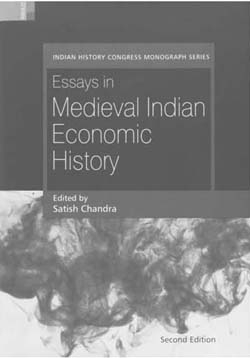There are certain books that never lose their charm and value despite the passage of time. It is mainly because of the intellectual stimulation their contents give us and the variety of academic debates they initiate. One of such works is Essays in Medieval Indian Economic History edited by Satish Chandra. This volume being a collection of representative articles taken out of the Proceedings of the Indian History Congress (1935–1986) and originally published in 1987 as a part of the Golden Jubilee Celebrations of the Indian History Congress, brings before us the cream of the historiographical traditions that this national forum of historians produced over years. It has been a delight to recall that this was one of the first books that I read almost 25 years ago when I channelized my research towards certain selected themes of economic history of medieval India. Now the revised version of this book, published to synchronize with the Platinum Jubilee Celebrations of IHC, makes available to the students of history the same papers within the larger thematic order and frames of recent debates and discourses on medieval Indian economy. It stands before us as no less than an intellectual companion both for teaching and research, provoking newer questions and generating fresher insights.
The compendium is broadly divided into two parts with the first focusing on agriculture and revenue collection, while the second set of papers dwells upon trade, market and currency. One can easily identify the tentative demarcating line of the agrarian landscape of medieval India evolving out of the underlying thread of connectivity moving through the various articles of the first part. Though themes like patterns and trends of agricultural production are sufficiently highlighted, the working of the medieval revenue system and its impact upon the lives of the Indian people form the most significant theme of study in this section. It is obvious that the economic health of the countryside is assessed on the basis of the nature of revenue-burden that fell upon the peasantry and the first three articles, which synoptically discuss the nature of revenue administration under Firoz Shah Thughluq, Sher Shah and Aurangazeb respectively, highlight not only the material base of the power edifice these rulers set up, but also the tentative economic position of the common people. The articles on the nature of taxation on the temples as well as its impact on the temple villages in the Telugu districts of Vijayanagara and rural taxation in eastern Rajasthan complement the picture obtained for the medieval Indian peasantry. B.R. Grover’s article on the classification of agrarian land for the purpose of revenue assessment during the time of Akbar and J.N. Phukan’s analysis of the copper plates of Ahom rulers regarding land-grants in Assam again bring before us the nuanced picture of the rural landscape in medieval India. Dilbagh Singh shows how the possessor of the office of patel got ‘social and economic superiority over the rest of his cultivators in the village’ over the years (p. 68). The issue is taken up from a different perspective by A.R. Kulkarni, who analyses deshmukhi watan to highlight ‘the feudal basis of the Maratha society in the eighteenth century’ (p.103).
The transformation of the madad-ima’ash holders from being ‘Army of Prayer’ consisting mostly of scholars, ascetics and destitute into zamindars, revenue-farmers and money-lenders against the background of declining imperial control is emphasized by Muzaffar Alam highlighting the subsequent aspects of social tension in the empire. An interesting study on the nature of the economy of Gujarat, which was extensively cultivated and had high urban-taxation with a sizeable share coming from customs, was done by Shireen Moosvi. Banking heavily upon the statistical material of A’ini-Akbari she meticulously examines the different facets of Gujarat economy with about Rs. 8, 15, 999 coming as port-revenues towards the close of the sixteenth century. Indu Banga’s analysis of the royal orders pertaining to the Jagirdari system issued by Maharaja Ranjit Singh between 1833 and 1834 highlight the administrative aspects of jagirs, dharmarth and ijara.

